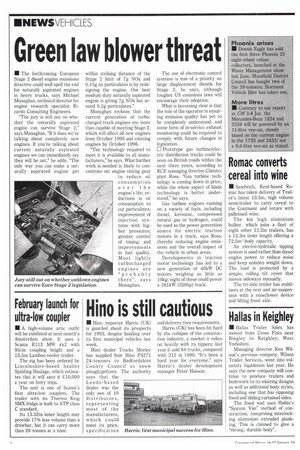Green law blower threat
Page 10

If you've noticed an error in this article please click here to report it so we can fix it.
• The forthcoming European Stage 2 diesel engine emissions directive could well spell the end for naturally aspirated engines in heavy trucks, says Michael Monaghan, technical director for engine research specialist Ricardo Consulting Engineers, "The jury is still out on whether the naturally aspirated engine can survive Stage 2," says Monaghan. "If it does we're talking about completely new engines. If you're talking about current naturally aspirated engines we can immediately say they will be out," he adds. "The only way you can make a naturally aspirated engine get within striking distance of the Stage 2 limit of 7g NOx and 0.15g on particulates is by redesigning the engine. Our best medium duty naturally aspirated engine is giving 7g NOx but around 0.2g particulates."
Monaghan reckons that the current generation of turbocharged truck engines are more than capable of meeting Stage 2, which will affect all new engines from October 1995 and existing engines by October 1996.
"The technology required to meet it is available to all manufacturers," he says. What further work is needed is likely to concentrate on: engine timing gear to reduce oil consumption over the engine's life; reductions in oil consumption to cut particulates; improvement of injection systems with higher pressures; greater control of timing; and improvements in fuel quality. Most lightly turbocharged engines are "probably there", says Monaghan. The use of electronic control systems is less of a priority on large displacement diesels for Stage 2, he says, although tougher US emissions laws will encourage their adoption.
What is becoming clear is that the role of the operator in ensuring emission quality has yet to be completely understood, and some form of in-service exhaust monitoring could be required to comply with future changes in legislation.
0 Prototype gas turbine/electric distribution trucks could be seen on British roads within the next three years, according to RCE managing director Christopher Ross. "Gas turbine technology is coming down in price, while the whole aspect of blade technology is better understood," he says.
Gas turbine engines running on a variety of fuels, including diesel, kerosine, compressed natural gas or hydrogen, could be used as the power generation source for electric traction motors in a truck, says Ross, thereby reducing engine emissions and the overall impact of the vehicle in urban areas.
Developments in traction motor technology has led to a new generation of 40kW DC motors weighing as little as 10kg: eight of these could power a 261kW (350hp) truck.




















































































